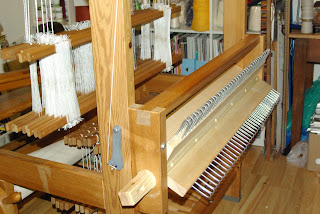 As part of the windfall I received from the wonderful weaver's stash, there were a lot of short ends of dyed 60/2 silk, obviously left over from various projects. They were in a veritable rainbow of mostly soft pastelly colours. Weighed, I found there were between 1g and 14 grams on each of the cones.
As part of the windfall I received from the wonderful weaver's stash, there were a lot of short ends of dyed 60/2 silk, obviously left over from various projects. They were in a veritable rainbow of mostly soft pastelly colours. Weighed, I found there were between 1g and 14 grams on each of the cones. The shortest cone (0.5g) was 8.5 m. So I thought that they would be great, combined and blended into a multicolour warp. For this first experiment I chose the peach, pink and softer purples above, with the odd strand of darker purple, blue and one of hot pink for emphasis. The result was the warp you see above.
The shortest cone (0.5g) was 8.5 m. So I thought that they would be great, combined and blended into a multicolour warp. For this first experiment I chose the peach, pink and softer purples above, with the odd strand of darker purple, blue and one of hot pink for emphasis. The result was the warp you see above.I beamed this at 60 epi, so I've now gone from 8epi to 16epi to 60epi with the sectional beam. I was starting to make plans to wind 60 short lengths of silk onto 60 cones for every one of 10 inch-wide sections when I realised that meant I'd spend all day winding 600 cones, and then winding them on to the beam 60 at a time. Crazy. It was also a recipe for tangles and madness. But I thought, if you can make multiple passes of a warp with a paddle when winding a warp, why shouldn't that work for sectional beaming as well? So when winding the cones for the warp, I wound 10 cones for each section, with 6 threads at a time on each, and I wound enough for 3 sections at a time onto each cone. That cut down the work involved considerably, and also allowed for gradual changes in colour as one colour of silk ran out and was replaced by another. A good way to use up various complentary ends of projects. Next time I use this approach, I may not wind the three ends of each set side-by-side. I'll spread them out, making the spread of colour more random.
There's 6.8 m of warp on the loom, which gives me enough for three scarves.
Next, as this is a seat-of-the-pants project - what threading, and which wefts? I'm going to thread this in a straight threading this afternoon, and the first scarf will be a two-shuttle undulating twill, in the mauve 60/2 skein of silk sitting on the centre of the warp, and the handspun, variegated silk cap, which is in pinks and mauves. I'll probably do a second in a twill pattern with a pale grey 60/2 silk weft, and the third in perhaps a series of paler pinks - we'll see.
If this is a success, I intend repeating the experiment with the pastel blue and green random ends. I also intend pulling out the knitting machine I bought but haven't really found the time to play with, and learn how to use it while making a simple v-neck top in faux mohair.
-------
For some reason, the internet connection at home does not allow me to log in, which means I'm unable to make posts from home. As I've earned some time off, I finish work at lunchtime today and don't even think about work again for a fortnight. That means no posts from me until next year. I'll have almost two full weeks at home to play with my hobbies, barring a few days in Brussels with some family for Xmas (I'm joining an Australian in Brussels for a Danish Christmas, as you do) and a day in London with a friend to see an Annie Leibowitz exhibition. Best of the season, and warm wishes to all.



















































